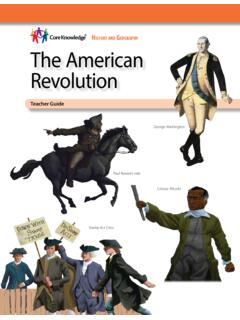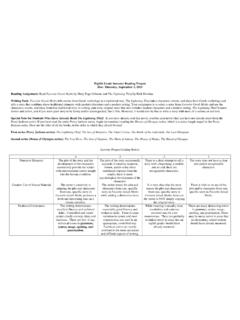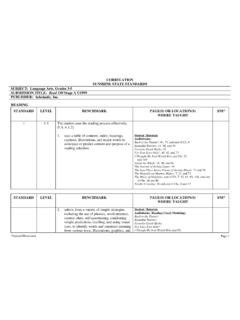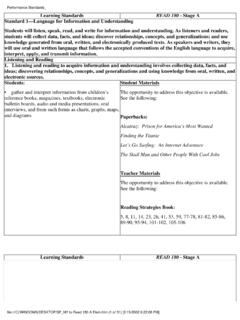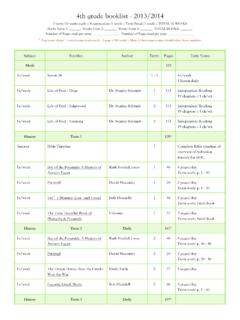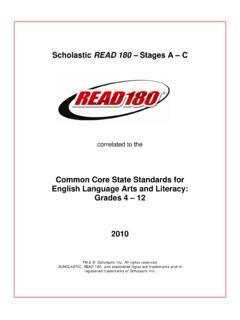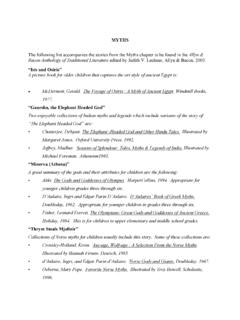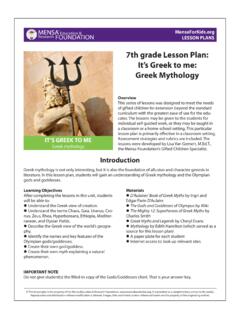Transcription of Gods of Thunder - Core Knowledge Foundation
1 gods OF Thunder : myths and Mythical Characters Grade Level: Third Grade Written by: Peggy Downs, Peak to Peak Charter School, Lafayette, CO Length of Unit: Ten lessons over 12 days (40 minutes each) I. II. 1. 2. 3. 1. 2. 3. 1. 2. ABSTRACT In this literature unit, students will explore myths and legends from Ancient Greece and Rome, and from Norse Mythology. There are many similarities between the two, and students will compare, contrast and evaluate these myths and the cultures that created them. Teaching strategies include class discussion, journal entries, graphic organizers, worksheets, and creative writing. Students will produce a Portfolio of Mythology as the Culminating Activity. This unit can be split into two sections to correspond with history units on Ancient Rome and the Vikings (six days greek and Roman myths , six days Norse myths ).
2 OVERVIEW A. Concept Objective(s) (taken from the Colorado State Standards for Reading and Writing, Standard 6, Third Grade) Students will read, respond to, and discuss a variety of literature. Students will understand the elements of fiction in mythology, including character, plot and setting. Students will understand that tales from different cultures reflect the values of those cultures. B. Content from the Core Knowledge Sequence More myths and Legends of Ancient Greece and Rome (page 68) a. Jason and the Golden Fleece b. Perseus and Medusa c. Cupid and Psyche d. The Sword of Damocles e. Damon and Pyhias f. Androcles and the Lion g. Horatius at the Bridge Norse Mythology (page 67) a. Asgard (home of the gods ) b. Valhalla c. Hel (underworld) d. Odin e. Thor f. Trolls g.
3 Loki h. Norse gods and English names for days of the week Literary Terms a. Fiction (page 68) b. Character c. Plot d. Setting C. Skill Objective(s) Students will orally summarize main points from fiction. (Core Knowledge Sequence, page 65) Students will use literary terminology, such as character, plot and setting. (Colorado State Standards for Reading and Writing, Standard 6, Third Grade) gods of Thunder , Grade 3 2002 Core Knowledge Conference 1 3. 4. 5. 6. III. 1. 2. 1. 2. 3. IV. V. 1. 2. 3. 1. Students will ask and pose plausible answers to how, why and what-if questions in interpreting text. (Core Knowledge Sequence, page 65) Students will compare, contrast, and evaluate text, developing the ability to enjoy literature and to articulate why they enjoy it.
4 (Colorado State Standards for Reading and Writing, Standard 6, Third Grade) Students will recognize the character traits displayed in myths , such as honesty, perseverance, and courage, and how they reflect the values of the culture. (Colorado State Standards for Reading and Writing, Standard 6, Third Grade) Students will produce a written work with a beginning, middle and end. (Core Knowledge Sequence, page 65) BACKGROUND Knowledge A. For Teachers Appendix A (Background Information) Read the introductions to the books listed below in RESOURCES. B. For Students Students should be familiar with the term myth from 2nd grade. Students should be familiar with the major gods , goddesses and mythological place names of Ancient Greece ( Hirsch, Jr. What Your 2nd Grader Needs to Know). Students should be familiar with the climates and major geographical features of the Mediterranean Region and Scandinavia ( Hirsch, Jr.)
5 What Your 3rd Grader Needs to Know). RESOURCES A. D Aulaire s Book of greek myths , by I. and D Aulaire (Lessons One and Two) B. D Aulaire s Norse gods and Giants, by I. and D Aulaire (Lessons Six, Seven, Eight, Nine, and Ten) C. favorite greek myths , by M. Osborne (Lesson Three) D. Roman myths and Legends, by A. Masters (Lesson Four) E. Androcles and the Lion, by Dennis Nolan (Lesson Five) F. What Your 3rd Grader Needs to Know, by Hirsch, Jr. (Lessons Six and Ten) G. Stolen Thunder : A Norse Myth, by S. Climo (Lesson Ten) LESSONS Lesson One: Jason and the Golden Fleece ( greek & Roman Mythology) this lesson will take two days A. Daily Objectives Concept Objectives a. Students will read, respond to, and discuss a variety of literature. b. Students will understand the elements of fiction in mythology, including character, plot and setting.
6 Lesson Content a. Jason and the Golden Fleece Skill Objectives a. Students will orally summarize main points from fiction. b. Students will ask and pose plausible answers to how, why and what-if questions in interpreting text. c. Students will use literary terminology, such as character, plot and setting. B. Materials Appendix A (Background Information) gods of Thunder , Grade 3 2002 Core Knowledge Conference 2 2. 3. 4. 5. 6. 1. 2. 3. 4. Appendix B (Student Journal), one for each student Appendix C (Classroom Graphic Organizer), prepared on flip chart or tag board to display Appendix D (Student Graphic Organizer), one for each student D Aulaire s Book of greek myths , by Ingri and Edgar Parin D Aulaire, The Golden Fleece, pages 162 175 A baby s lambskin blanket to show as a golden fleece, if available C.
7 Key Vocabulary Hera (Juno) Queen of the gods Argo the magic ship built for Jason Argonauts the adventurous men who sailed with Jason Fleece the wool obtained from a sheep when it is sheared D. Procedures/Activities DAY 1 1. 2. 3. 4. Introduce the vocabulary words. Write the words on the board and ask for volunteers who might be able to define these words. Write down any acceptable responses. Use the definitions above to refine or clarify their responses. Read the story, The Golden Fleece, straight through. Distribute the student journal pages. Have the students write down three details they remember from the myth, and at least one how, why or what-if question. Tell the students they will be creating a Portfolio of Mythology at the end of this unit, which will include these journal pages and other activities. Tell the students you will be discussing the myth and their questions in the next lesson.
8 DAY 2 1. 2. i. ii. iii. iv. i. ii. iii. Discuss the students notes and questions from the previous session. Introduce the following literary terms: a. Fiction a story that did not really happen b. Characters the people in a story; you can learn about a character from story clues that tell you: what the character says, what the character does, what other characters say about the character, what the author says about the character. c. Plot the important events that happen in a story; a story has a beginning, middle, and end: beginning: you find out what problem the characters have middle: you find out what the characters do to solve their problem end: you find out how the characters solve their problem, their solution 3. Review the myth with the class. Ask for students to identify the main character of the story. Ask for volunteers to summarize the story, including the beginning, middle and end.
9 A. Main Character: Jason b. Plot: In the beginning, Jason tries to reclaim his throne from his uncle (problem: his uncle doesn t want to give him the throne). His uncle says he must complete a task before he can have the throne: he has to bring back the Golden Fleece. In the middle, he has many adventures and he meets a beautiful young witch named Medea who helps him (what the character does to solve his problem). Then, he brings the Golden Fleece gods of Thunder , Grade 3 2002 Core Knowledge Conference 3 home to his uncle. Finally, Jason is King for a while, but he doesn t keep his promise to Medea and he loses his kingdom (solution). 4. 5. 6. 1. 1. 2. 3. 1. 2. 3. 4. 1. 2. 3. 1. 2. 3. 4. Display the classroom graphic organizer and distribute copies of the student graphic organizer. Complete the organizer with the students, having them fill in the blanks on their copies.
10 Use the following discussion questions or your own: a. Who are the good people in this story? Who are the bad people? Why? b. What task does the hero need to complete? c. What magic appears in the story? d. What is the reward or punishment? Who gets it? Why? Have the students answer the following questions on the student journal pages: a. How did Jason find the Golden Fleece? b. Why did Hera help Jason? c. What if Hera had not helped Jason? E. Assessment/Evaluation Collect and review the students notes. Lesson Two: Perseus and Medusa ( greek & Roman Mythology) A. Daily Objectives Concept Objectives a. Students will read, respond to, and discuss a variety of literature. b. Students will understand the elements of fiction in mythology, including character, plot and setting. Lesson Content a. Perseus and Medusa Skill Objectives a.




